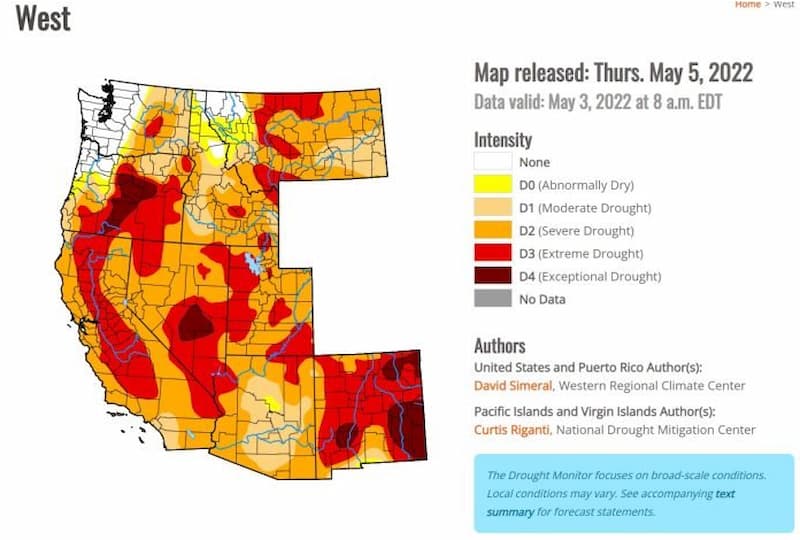(NWO Report) Against the backdrop of the water crisis in the Colorado River Basin, where the country’s largest reservoirs are plunging at an alarming rate, California’s two largest reservoirs — Shasta Lake and Lake Oroville — are facing a similar struggle.
Related Extreme Texas Weather: Drought, 178 Wildfires, Tornados, and Flash Floods Prompt Evacuations
by Staff Writer, May 8th, 2022
Years of low rainfall and snowpack and more intense heat waves have fed directly to the state’s multiyear, unrelenting drought conditions, rapidly draining statewide reservoirs. And according to this week’s report from the US Drought Monitor, the two major reservoirs are at “critically low levels” at the point of the year when they should be the highest.
This week, Shasta Lake is only at 40% of its total capacity, the lowest it has ever been at the start of May since record-keeping began in 1977. Meanwhile, further south, Lake Oroville is at 55% of its capacity, which is 70% of where it should be around this time on average.
Shasta Lake is the largest reservoir in the state and the cornerstone of California’s Central Valley Project, a complex water system made of 19 dams and reservoirs as well as more than 500 miles of canals, stretching from Redding to the north, all the way south to the drought-stricken landscapes of Bakersfield.
Shasta Lake’s water levels are now less than half of historical average. According to the US Bureau of Reclamation, only agriculture customers who are senior water right holders and some irrigation districts in the Eastern San Joaquin Valley will receive the Central Valley Project water deliveries this year.
“We anticipate that in the Sacramento Valley alone, over 350,000 acres of farmland will be fallowed,” said Mary Lee Knecht, public affairs officer for the Bureau’s California-Great Basin Region. For perspective, it’s an area larger than Los Angeles. “Cities and towns that receive [Central Valley Project] water supply, including Silicon Valley communities, have been reduced to health and safety needs only.“
A lot is at stake with the plummeting supply, said Jessica Gable with Food & Water Watch, a nonprofit advocacy group focused on food and water security as well as climate change. The impending summer heat and the water shortages, she said, will hit California’s most vulnerable populations, particularly those in farming communities, the hardest.
“Communities across California are going to suffer this year during the drought, and it’s just a question of how much more they suffer,” Gable said. “It’s usually the most vulnerable communities who are going to suffer the worst, so usually the Central Valley comes to mind because this is an already arid part of the state with most of the state’s agriculture and most of the state’s energy development, which are both water-intensive industries.”
‘Only 5%’ of water to be supplied
Lake Oroville is the largest reservoir in California’s State Water Project system, which is separate from the Central Valley Project, operated by the California Department of Water Resources (DWR). It provides water to 27 million Californians and 750,000 acres of farmland.
Last year, Oroville took a major hit after water levels plunged to just 24% of total capacity, forcing a crucial California hydroelectric power plant to shut down for the first time since it opened in 1967. The lake’s water level sat well below boat ramps, and exposed intake pipes which usually sent water to power the dam.
Although heavy storms toward the end of 2021 alleviated the lake’s record-low levels, resuming the power plant’s operations, state water officials are wary of another dire situation as the drought worsens this summer.
“The fact that this facility shut down last August; that never happened before, and the prospects that it will happen again are very real,” California Gov. Gavin Newsom said at a news conference in April while touring the Oroville Dam.
According to the DWR, Oroville’s low reservoir levels are pushing water agencies relying on the state project to “only receive 5% of their requested supplies in 2022,” said Ryan Endean, spokesperson for the DWR. “Those water agencies are being urged to enact mandatory water use restrictions in order to stretch their available supplies through the summer and fall.”
The Bureau of Reclamation and the DWR, in concert with federal and state agencies, are also taking unprecedented measures to protect endangered winter-run Chinook salmon for the third drought year in a row.
Reclamation officials are in the process of securing temporary chilling units to cool water down at one of their fish hatcheries.
Shasta Lake, California’s largest water reservoir, is the key source for collecting and delivering large amounts of water through the Central Valley and into the Sacramento River Delta where the California State Water Project (aka California Aqueduct) begins, moving water to Southern California and all regions in between.
Both reservoirs are a vital part of the state’s larger water system, interconnected by canals and rivers. So even if the smaller reservoirs have been replenished by winter precipitation, the plunging water levels in Shasta and Oroville could still affect and drain the rest of the water system.
The water level on Folsom Lake, for instance, reached nearly 450 feet above sea level this week, which is 108% of its historical average around this time of year. But with Shasta and Oroville’s low water levels, annual water releases from Folsom Lake this summer may need to be bigger than normal to make up for the other reservoirs’ significant shortages.
California depends on storms and wintertime precipitation to build up snowpack in the Sierra Nevada, which then gradually melts during the spring and replenishes reservoirs.
Facing back-to-back dry years and record-breaking heat waves pushing the drought into historic territory, California got a taste of the rain it was looking for in October, when the first big storm of the season pushed onshore. Then in late December, more than 17 feet of snow fell in the Sierra Nevada, which researchers said was enough to break decades-old records.
But precipitation flatlined in January, and water content in the state’s snowpack this year was just 4% of normal by the end of winter.
Further down the state in Southern California, water district officials announced unprecedented water restrictions last week, demanding businesses and residents in parts of Los Angeles, Ventura and San Bernardino counties to cut outdoor watering to one day a week beginning June 1.
Gable said as California enters a future much hotter and drier than anyone has experienced before, officials and residents need to rethink the way water is managed across the board, otherwise the state will continue to be unprepared.
Water is supposed to be a human right. But withi this megadrought, it is going to be a new cause of war, even civil wars… [CNN]
Stillness in the Storm Editor: Why did we post this?
The news is important to all people because it is where we come to know new things about the world, which leads to the development of more life goals that lead to life wisdom. The news also serves as a social connection tool, as we tend to relate to those who know about and believe the things we do. With the power of an open truth-seeking mind in hand, the individual can grow wise and the collective can prosper.
– Justin
Not sure how to make sense of this? Want to learn how to discern like a pro? Read this essential guide to discernment, analysis of claims, and understanding the truth in a world of deception: 4 Key Steps of Discernment – Advanced Truth-Seeking Tools.
Stillness in the Storm Editor’s note: Did you find a spelling error or grammatical mistake? Send an email to corrections@stillnessinthestorm.com, with the error and suggested correction, along with the headline and url. Do you think this article needs an update? Or do you just have some feedback? Send us an email at sitsshow@gmail.com. Thank you for reading.
Source:
DIRECT DONATION
Support our work! (Avoid Big Tech PayPal and Patreon)




Mismanagement, or by design? THAT is the question.